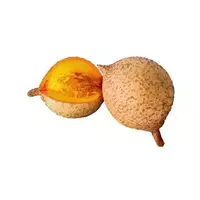Báil

The bail belongs to the trees of the root family, and it can be found in the wild in the wooded areas of Sri Lanka, Pakistan, Malaysia, Indochina, the Philippines, Bangladesh and India. Adult trees reach a height of fifteen meters, but this takes quite a long time, since they grow unusually slowly. The leaves of the bail are large in size and have an oval shape.
The fruit of this tree, which bears the same name, is slightly elongated in length and resembles the apple we are used to in appearance. By the way, this is probably why this fruit has a stone apple for the second name. This is how he was nicknamed in view of the unusually hard, rather wooded peel, so it is impossible to clean the bail with your hands. For these purposes, a hammer or hatchet is used, with which the shell easily breaks through. In an immature form, the color of the beal peel is gray-green, and after ripening it acquires a light yellow color. In diameter, the fruits reach 20 centimeters, but the average size is still considered no more than 10 centimeters.
After opening the strong shell, the juicy flesh of the bail is exposed, which is distinguished by orange color, exotic aroma and light sweetness. Moreover, when eating this fruit, you can find that the flesh knits a little - like persimmon. It can be divided into segments, inside which there are small bones, covering with short hairs.
Bail fruits are often eaten fresh, used not only in pure form, but also for the preparation of a variety of fruit salads and other sweet dishes. Frozen bale-based meals are especially popular - they can be ice cream, sorte, sherbet, jelly and many other treats.
However, the most common use of this fruit is when dried. Such dried fruit is most often added to tea. This drink, which acts as a natural remedy, is useful for both children and adults. Tea based on dried bail helps to cope with various colds, as well as increases immunity, fights bronchitis and asthma.
To make this wonderful tea, you need to split the dried fruit into parts and put a couple of pieces of fruit in the brew, and then pour boiling water. After 15 minutes, the magic remedy is ready. In addition to tea, an unusually tasty, fragrant and sweet cool drink called sharbat is made from bail. Moreover, from 1 large fruit you can make as much as six liters of this excellent drink.
bayel 48 kCal
Energy value of the bail (Ratio of proteins, fats, carbohydrates - ju):
Proteins: 0.6 g (~ 2 kCal)
Fats: 0.3 g (~ 3 kCal)
Carbohydrates: 9g (~ 36kCal)
Energy ratio (bj | y): 5% | 6% | 75%
 Español
Español Français
Français Português
Português Русский
Русский 简体中文
简体中文 繁體中文
繁體中文 日本語
日本語 한국어
한국어 العربية
العربية Türkçe
Türkçe Қазақ
Қазақ Deutsch
Deutsch Italiano
Italiano Українська
Українська
